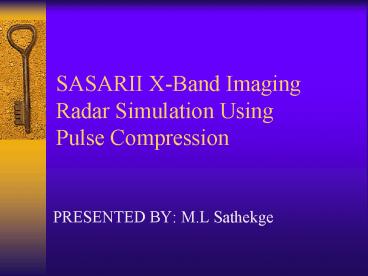SASARII XBand Imaging Radar Simulation Using Pulse Compression - PowerPoint PPT Presentation
1 / 14
Title:
SASARII XBand Imaging Radar Simulation Using Pulse Compression
Description:
Effect of an analog-to-digital converter (ADC) full-scale resolution on the system's resolution ... Good trade-off between filter roll-off and group delay ... – PowerPoint PPT presentation
Number of Views:81
Avg rating:3.0/5.0
Title: SASARII XBand Imaging Radar Simulation Using Pulse Compression
1
SASARII X-Band ImagingRadar Simulation
UsingPulse Compression
- PRESENTED BY M.L Sathekge
2
AGENDA
- INTRODUCTION TO RADAR
- PROBLEM DESCRIPTION
- PROPOSED SOLUTIONS
- DESIGN STATISTICS
- SIMULATION TESTS AND RESULTS
- CONCLUSIONS
3
INTRODUCTION TO RADAR THEORY
The filling of the Katse Dam in
Lesotho differential InSAR to the mapping of
ground deformation induced by the loading effect
of a large reservoir.
4
PROBLEM DESCRIPTION
- Component limitations on the systems resolution
- - Filters for up-conversion and down-conversion
- - Noise generated by components
- - Non-linearity in Components
- Effect of an analog-to-digital converter (ADC)
full-scale resolution on the systems resolution
5
PROPOSED SOLUTIONS
- Solutions to filter limitations
- - 5th order Butterworth Filters
- - Good trade-off between filter roll-off
and group delay - Non-linearity and noise generated by components
- - Operation of mixers, splitters and amplifiers
in their linear region - Solution to ADC resolution limitations
- - A 14-bit ADC is used. The systems dynamic
range is determined by its quantisation level.
6
CHIRP RADAR SIMULATION
IF1 at 158MHz And IF2 At 1300MHz
DAC
Chirp Formation
I
RF _at_ 9300MHz
Delay
Q
I
Matched Filter
ADC
Receiver With two Down-Conversion Stages
Q
7
Chirp Signal _at_ IF1(158MHz)
8
Complex Chirp _at_ 158MHz
9
DESIGN STATISTICS
- Transmission power is 3.5kW at frequency of
9.3GHz - Systems noise figure is 2dB and worst noise
figure is 6dB - The MDS is at 95dBm
- The Radars maximum range is 11538m.
- The signal to noise ratio at the receiver output
- after matched filtering is 3dB
- A 14bit ADC with a sample rate of 210MHz was
used to sample - the signal
- The ADCs quantisation voltage is 0.00012207V
- The receiver noise level is 666mV
10
SIMULATION TEST
- Filter test
- 5th Butterworth VS 9th order Chebyshev Group
Delay Response
11
SIMULATION TEST
- Power Return Test
- Corner Reflector
- With 95dB
- Attenuation
12
TEST RESULTS
13
Non-linearity in Components
14
Conclusions
- A 130dB attenuation sets the minimum
detectable signal in the receiver - In non-linearity test mixer inter-modulation
products put stress on the filter roll-off (Sharp
filter roll-off required), hence group delay. - With a gain of 77.5dB the receivers MDS
improved from 50dBm to - -95dBm
- Pulse Integration (output stacking) must be done
to improve the signal to noise ratio. - Good care must be taken to operate RF components
according to their specifications to avoid
non-linearity































